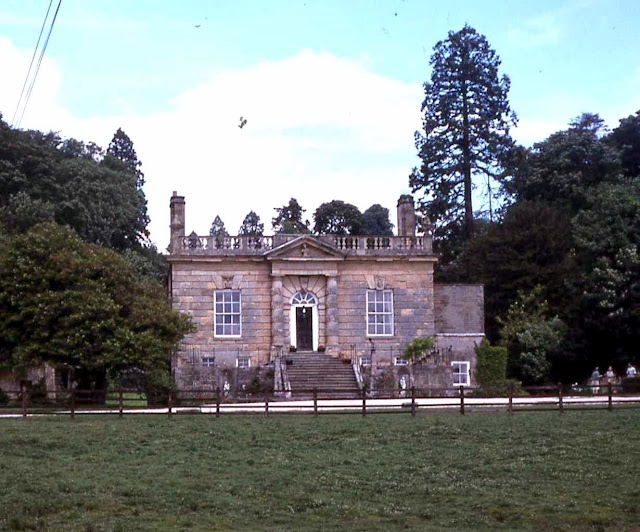We have some very fine
buildings in this country. There are
some curious buildings, some that are not quite what they seem to be and others
with a story to tell. This blog reveals all :
The smallest house
The Old Bridge House
Another curious tiny building is
to be found in Ambleside in Cumbria, built on a stone arch spanning Stock Beck,
it is known as The Old Bridge House.
This charming early 16th century structure was originally
built as a summer house for Ambleside Hall, but subsequently became a
dwellinghouse. In the mid 19th
century, Charity Rigg, his wife and six children are said to have lived in this
tiny one up and one down house. To get
from the tiny downstairs room with its little fireplace, they had to go outside
where stone steps lead to the equally tiny upper room.
This building is now in the care
of the National Trust.
The smallest stately home
What is claimed to be Britain’s
smallest stately home can be seen alongside the A170 at Ebberston near Scarborough
in North Yorkshire. Ebberston Hall was
built in Palladian style in 1718 for the then Scarborough M.P, William
Thompson, and has just eleven rooms in all.
The main entrance is made particularly impressive by the sweeping flight
of steps leading up to the grand classically treated doorway, giving access to
the grandeur of this miniature mansion.
Two small lodges, originally on either side of the house were demolished
in the 19th century.
The present owners are struggling
to maintain and restore this unique house, which is open to the public in the
summer months.
The Ugly House
The Ty Hyll, or Ugly House, is
situated a few miles west of Betwys-y-Coed in the Snowdonia National Park of
North Wales. It is a Ty Yn Y Nos or house of the night! Apparently in the 15th century,
when this house was built, anybody who could build a rough house overnight and
have smoke coming out of the chimney by dawn, was able to claim the land
freehold. Furthermore, the boundary of
his land could be established by the distance one could throw an axe from the
four corners of the building. According
to legend, the Ugly House was so built by two brothers. The house would originally have had a roof
of heather thatch, eventually being replaced by slates as seen today.
Towards the end of the 19th
century the house had become derelict but was made habitable by a man called
Riley, and he lived there with his wife until the 1960’s when they died, and
once again the cottage fell into disrepair.
In 1988 it was bought by the Snowdonia National Park Society who
restored it and it is now open to the public.
The Image House
A small cottage on the roadside
of the A49 near to its junction with the turn to Bunbury in Cheshire, now a
listed building, has a similar history. The only apparent
curiosity about this building are the strange images which adorn its façade,
but it is also in fact a ‘house of the night‘.
The story goes that back in the 19th century, a man called
Vicars was convicted of poaching and was transported to Australia. Apparently he found his way back to Bunbury
where he built the cottage overnight and had smoke coming out of the chimney by
dawn, which gave him the right to the freehold of the land. It is said that he put the images on the
façade as a curse on the people who had denigrated him.
The Star Hotel
The Star Hotel in the High Street at Moffat in the Scottish
Borders dates to the late 1700’s. This old inn, only 20 feet wide and 162 feet
long, is listed in the Guiness Book of Records as being the world’s narrowest
hotel.
The Coffin House
This
coffin shaped house in King Street, Brixham in Devon has a story to tell. It is said
that a man disapproved of his daughter's impending marriage and said that he
would see her in a coffin before he would agree to her proposed marriage. Her
suitor bought this house, called it Coffin House and told the father that his
wishes could be met. The father was impressed and gave his consent to the
marriage.
The Star Hotel
The Star Hotel in the High Street at Moffat in the Scottish
Borders dates to the late 1700’s. This old inn, only 20 feet wide and 162 feet
long, is listed in the Guiness Book of Records as being the world’s narrowest
hotel.
The Huer's Hut
The Huer’s Hut is a small
white Grade 11 listed building on a headland above the harbour at Newquay in Cornwall.
A plaque near the building
tells us :
‘This building thought to
date from the 14th c. was used as a
look-out by a Huer at the
time of year when shoals of pilchards
were expected in the bay. A
call on his horn raised the hue and
cry and alerted the
townsfolk to the arrival of the fish. By means
of hand signals the Huer
enabled the fishermen to position their
boats and encircle the
shoal with their nets.
Prior to its use by the
Huer this hut may have been a
Hermitage. The hermit
possibly being the person entrusted with
the lighting of the beacon
fire for the guidance of shipping.
Externally this building
has a large typically Cornish late
medieval chimney and a
narrow stairway leading to the roof.
There are two windows with
drip moulds one of which (now
blocked) has a mullion
visible from the inside. Here too, can be seen
an early fireplace altered
in the 19th c. possibly during the
Restoration of 1836.'

.JPG)






.JPG)
.JPG)



No comments:
Post a Comment